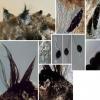
12-10-2012 16:35
René DougoudChers Tous,Je recherche la publication de Melastiz

11-10-2012 01:23
Esquivel-Rios EduardoGreetings all.Recently collect this fungus on a de

12-10-2012 00:15
Esquivel-Rios EduardoHi AllPlease i need a experts confirmation if th

09-10-2012 16:36
René DougoudChers Tous,Je recherche l'article suivant:MALENCON

10-10-2012 20:30
Adrian CarterHello Forum:Attached are some photos from dried ma

10-10-2012 01:31
I thought with a good Key they might become a litt

09-10-2012 22:09
Esquivel-Rios EduardoHi All.I found this Poronia in cow dung, have a la

10-10-2012 01:46
This time I am sure I have at last managed to give
 This is yet another Podospora which has developed on a collection of rabbit dung (along with P. (Schizothecium) tetraspora, P. fimiseda and P. pleiospora).
This is yet another Podospora which has developed on a collection of rabbit dung (along with P. (Schizothecium) tetraspora, P. fimiseda and P. pleiospora).It seems to sit uncomfortably between P. setosa and P. curvicolla.
For the former are characters like the shape of the asci (clavate, not saccate), no asci with 256 spores and the gelatinous appendages which are persistent on the mature spores and do not disappear in water mounts.
But the spores seem small for P. setosa and would fit better in P. curvicolla - they measure 16.4-17.3 x 10.4-11.7µm; also in some cases the hairs could be considered 'agglutinated'. I know there are ASCOFrance members with lots of experience of these coprophiles, and would again be grateful for assistance.
Cordialement
Chris

It is sometimes difficult to separate these two species, but the size of the spores and "agglutined" hairs closer to curvicolla.
It is important to measure a large number of spores to have a mean, especially since it is sometimes difficult to count the number of spores within the ascus. I also picked up some copies of P.curvicolla with little hairs "agglutined".
Michel.

